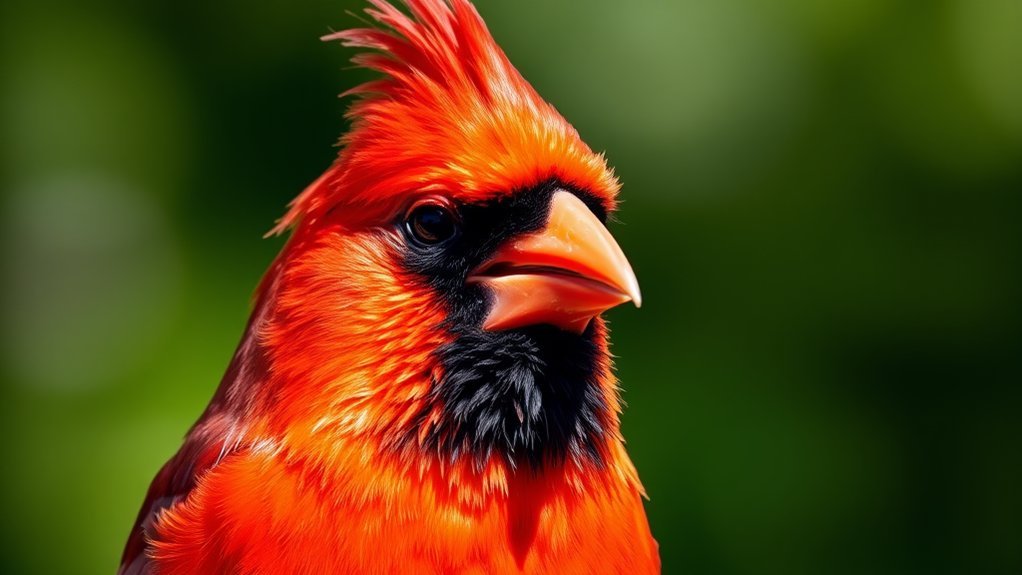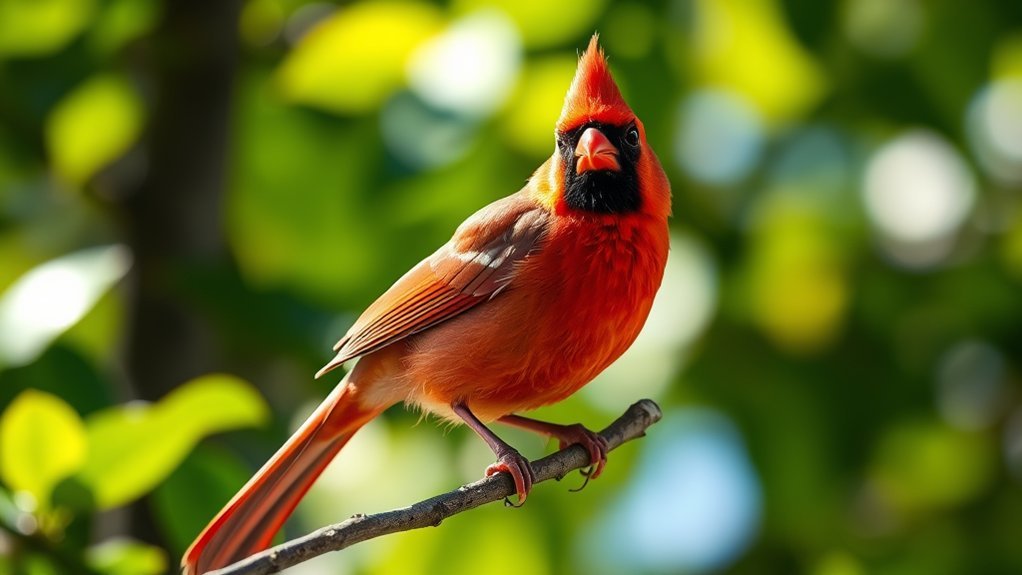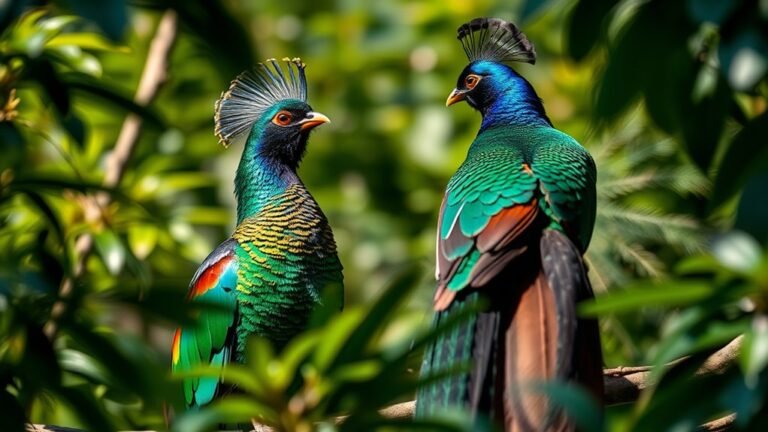Northern Cardinal Guide: Beauty in Red
The Northern Cardinal is a beautiful bird known for its bright red feathers in males and the more subtle colors in females. These birds thrive in different environments, demonstrating their adaptability. Their physical characteristics and behaviors help us understand their importance in nature.
Cardinals have specific social structures and communicate through distinct vocalizations. Exploring these social aspects can enhance our understanding of their habitat and survival. Enjoy watching these vibrant birds as they contribute to their ecosystem.
Key Takeaways
- Male Northern Cardinals have bright red feathers and a notable black mask. Female cardinals have warm brown feathers with touches of red.
- Northern Cardinals live in different places, such as woods, gardens, and neighborhoods. They adapt well to their surroundings.
- Their diet includes seeds, fruits, and insects. They have strong beaks that help them crack tough seeds.
- During mating, cardinals perform courtship displays. They build strong nests in dense shrubs or trees for their young.
- Cardinals are known for their bright songs and sharp calls, especially during breeding time.
Physical Characteristics of Northern Cardinals

The Northern Cardinal is known for its bright colors and unique features. The male has vivid red feathers that can range from bright scarlet to dark crimson. It also has a distinctive black mask around its face, adding to its bold look.
The female is less vibrant, showcasing warm brown tones mixed with hints of red, still reflecting elegance.
Both male and female cardinals have strong, conical beaks. These beaks are effective for cracking seeds, which helps them adapt to various environments.
Their colorful feathers and specialized beaks make Northern Cardinals easy to identify and enjoyable to observe for birdwatchers and nature lovers alike.
Habitat and Range
Northern Cardinals thrive in wooded areas, gardens, and shrubby edges. They prefer habitats with dense plants for shelter and nesting. You can commonly find them in parks and suburban neighborhoods, showing their ability to live alongside people.
Over the past century, Northern Cardinals have expanded their range northward, likely due to climate change and available habitats. While exploring areas with these vibrant birds, look for shrubby thickets or low tree canopies, as these locations often indicate their presence.
Feeding Habits and Diet

Northern Cardinals have a diverse diet that shows their adaptability. They prefer sunflower seeds, safflower seeds, and peanuts. Their strong bills help them crack open tough seeds, demonstrating their specialized feeding behavior.
They often forage in pairs or small groups, which enhances social bonds among them.
In addition to seeds, Northern Cardinals eat fruits, insects, and spiders, especially during breeding season when they need more protein.
Observing their feeding habits helps you understand their role in the ecosystem and deepens your appreciation for these beautiful birds. Watching them adds joy to your experience in nature.
Breeding and Nesting Behavior
Northern Cardinals exhibit clear breeding and nesting behaviors that reveal their reproductive strategies and habitat choices. They typically mate from late winter to early spring.
Their mating rituals include courtship displays and gentle feeding between partners.
Female Cardinals choose nesting sites in dense shrubs or trees, favoring locations that offer good cover. They collect materials like twigs, grasses, and leaves to build sturdy nests for their young.
The male Cardinal often stays close, defending their territory and ensuring the safety of the area. This teamwork between partners boosts their chances of successful reproduction and highlights their connection to each other and the environment.
Vocalizations and Communication

Northern Cardinals are known for their vibrant vocal sounds. These birds use various songs to communicate. They sing to attract mates and defend their territory. Their calls include cheerful whistles and sharp chip notes, displaying a range of sounds.
Seasonal changes affect their vocal habits. During breeding season, male cardinals sing more often and loudly to show dominance. In colder months, their sounds may become softer, reflecting changes in their social structure.
Listening to the Northern Cardinals can deepen your connection with nature. Their vocalizations reveal their behaviors and interactions. Enjoy watching and listening to these lively birds.
Behavior and Social Structure
Northern Cardinals have a clear social structure that affects their behaviors. They establish social hierarchies, impacting interactions within their flocks and influencing mating opportunities.
During the breeding season, male cardinals defend their territories. They do this by singing loudly and showing off their bright feathers. These actions help them establish dominance and maintain order in their groups.
Cardinals also form stable pairs, highlighting their commitment to social bonds. Their behaviors blend competition and cooperation, creating a balance that supports their survival.
Conservation Status and Challenges
Northern Cardinals have vibrant social lives, but they face serious challenges that threaten their survival. Their population is declining due to several key issues:
- Habitat loss: Urbanization and farming take away the natural spaces these birds need to live.
- Climate change: Changes in weather affect their breeding and food supply.
- Invasive species: Predators like cats and competing birds push cardinals out of their homes.
To protect Northern Cardinals, we must focus on these problems together. Knowing their habitat needs and the threats they face can inspire people to help.
Attracting Northern Cardinals to Your Garden
To attract Northern Cardinals to your garden, create a friendly environment for them. Focus on their food preferences. They enjoy seeds from sunflowers, safflower, and millet. Place feeders filled with these seeds to draw them in.
You can also plant specific flowers and shrubs to make your garden more appealing. Cardinal flowers and native shrubs like elderberry and dogwood provide food and shelter for them.
Design your garden with open spaces and dense areas to support their foraging and nesting. Ensure a fresh water source is available, as this will further invite them.
Frequently Asked Questions
What Are the Differences Between Male and Female Northern Cardinals?
Male Northern Cardinals are bright red in color, making them easy to spot in the wild. Female Cardinals are more brown and have a softer appearance. During nesting season, females often engage in protective and nurturing behaviors.
Do Northern Cardinals Migrate or Stay in One Area Year-Round?
Northern cardinals do not migrate. They stay in one area year-round. During winter, you can find them foraging together in your backyard. Their presence often encourages community feeding. This creates a sense of connection and enjoyment among bird lovers.
How Long Do Northern Cardinals Typically Live in the Wild?
Northern cardinals usually live three to five years in the wild. Their lifespan depends on factors like habitat quality and predator presence. Recognizing the lifespan of northern cardinals can enhance your appreciation for these striking birds and their role in the ecosystem.
What Are Common Predators of Northern Cardinals?
Northern cardinals face several threats from predators. Cats and hawks pose significant risks to these birds. By understanding their predators, we can better appreciate the challenges cardinals face and support their conservation. Protecting these beautiful birds helps ensure they thrive in their habitats.
Can Northern Cardinals Be Kept as Pets?
You typically cannot keep Northern Cardinals as pets because of legal restrictions. If you are thinking about it, be aware of their care needs. They require a proper diet and environment that resembles their natural habitat. This ensures they stay healthy and happy.

Kashvi is a passionate bird enthusiast and nature lover who has been fascinated by the world of birds for years. With a keen eye for detail and a love for learning, Kashvi is dedicated to sharing her knowledge and insights with fellow bird enthusiasts on Avian Enthusiasts. Through her engaging and informative articles, Kashvi aims to inspire others to join her in exploring the fascinating world of birds and to promote a deeper appreciation for these incredible creatures.







